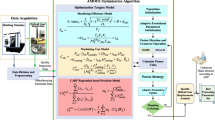Abstract
Precision forging of the helical gear is a complex metal forming process under coupled effects with multi-factors. The various process parameters such as deformation temperature, punch velocity and friction conditions affect the forming process differently, thus the optimization design of process parameters is necessary to obtain a good product. In this paper, an optimization method for the helical gear precision forging is proposed based on the finite element method (FEM) and Taguchi method with multi-objective design. The maximum forging force and the die-fill quality are considered as the optimal objectives. The optimal parameters combination is obtained through S/N analysis and the analysis of variance (ANOVA). It is shown that, for helical gears precision forging, the most significant parameters affecting the maximum forging force and the die-fill quality are deformation temperature and friction coefficient. The verified experimental result agrees with the predictive value well, which demonstrates the effectiveness of the proposed optimization method.
Similar content being viewed by others
References
J. C. Choi and Y. Choi, Precision forging of spur gears with inside relief, Int. J. Mach. Tools Manuf., 39 (1999) 1575–1588.
J. C. CHoi, Y. Choi and S. J. TAK, The forging of helical gears (I): experiments and upper-bound analysis, Int. J. Mech. Sci., 40 (1998) 325–337.
S. K. Samanta, Helical gear: a noble method of manufacturing it, Proc. of the 4th North American Metalworking Research Conf., USA (1976) 199–205.
J. C. Choi, H. Cho and H. Kwon, A new extrusion process for helical-gears:experiment study, J. Mate.r Process Technol., 43 (1994) 35–53.
J. C. Choi, Y. Choi and S. J. Tak, The forging of helical gears (II): comparisons of the forging processes, Int. J. Mech. Sci., 41(1999) 725–739.
V. Szentmihalyi, K. Lange, Y. Tronel, J. L. Chenot and R. Ducloux, 3-D finite-element simulation of the cold forging of helical gears, J. Mater. Process Technol., 43 (1994) 279–291.
K. Lange and V. Szentmihalyi, Optimized cold forging of helical gears by FEM-simulation, Proc. of 9th International Cold Forging Congress, U.K. (1995) 283–289.
Y. B. Park and D. Y. Yang, Finite element analysis for precision cold forging of helical gear using recurrent boundary conditions, Proc. of the KSME(I), Korean (1995) 296–301.
S.-Y. Jung, M.-C. Kang, C. Kim and C.-H. Kim et al., A study on the Extrusion by a two-step process for manufacturing helical gear, Int. J. Adv. Manuf. Technol., 41 (2009) 684–693.
G. Zhao, E. Wright and R. V. Grandhi, Sensitivity analysis based preform die shape design for net-shape forging, Int. J. Mach. Tools Manuf., 37 (1997) 1251–1271.
G. Zhao, X. Ma, X. Zhao and R. V. Grandhi, Studies on optimization of metal forming processes using sensitivity analysis methods, J. Mater. Process Technol., 147 (2004) 217–228.
X. Zhao, G. Zhao, G. Wang and T. Wang, Preform die shape design for uniformity of deformation in forging based on preform sensitivity analysis, J. Mater. Process Technol., 128 (2002) 25–32.
X. Chen and J. D. Won, Gear hot forging process robust design based on finite element method, J. Mech. Sci. Tech., 22 (2008) 1772–1778.
Y. K. Lee, S. R. Lee, C. H. Lee and D. Y, Yang, Process modification of bevel gear foging using three-dimensional finite element analysis, J. Mater. Process Technol., 113 (2001) 59–63.
X. He, Z. Yu and X. Lai, Robust parameters control methodology of microstructure for heavy forgings based on Taguchi method, Materials & Design, 30 (2009) 2084–2089.
H. Zhijun, Three design, China Mechanical Industry Press, Beijing (1992).
H. Oktem, T. Erzurumlu and I. Uzman, Application of Taguchi optimization technique in determining plastic injection molding process parameters for a thin-shell part, Materials & Design, 28 (2007) 1271–1278.
T.-R. Lin, Optimisation technique for face milling stainless steel with multiple performance characteristics, Int. J. Adv. Manuf. Technol., 19 (2002) 330–335.
C. Y. Nian, W. H. Yang and Y. S. Tarng, Optimization of turning operations with multiple performance characteristics, J. Mater. Process Technol., 95 (1999) 90–96.
M. Ogura and K. Kondo, Precision forging of helical gears utilizing divided-flow method, The Seventh Aisa Symposium on Precision Forging, China (2000) 67–70.
Author information
Authors and Affiliations
Corresponding author
Additional information
This paper was recommended for publication in revised form by Editor Dae-Eun Kim
Wei Feng is a Ph.D candidate and is also a lecturer of Material processing Engineering at Wuhan University of Technology. She received her M.S. degree in Pressure Processing from Wuhan University of Technology, China, in 2002. Her research areas include advanced forming and its applications.
Lin Hua received his M.S. degree in Pressure Processing from Wuhan University of Technology, China, in 1985. He then received his Ph.D. degree in Mechanical Engineering from Xi’an Jiaotong University, China, in 2000. Dr. Hua is currently a professor at the School of Automotive Engineering, Hubei Key Laboratory of Advanced Technology of Automotive Parts at Wuhan University of Technology, China. Dr. Hua’s research interests include advanced forming and equipment technology.
Rights and permissions
About this article
Cite this article
Wei, F., Lin, H. Multi-objective optimization of process parameters for the helical gear precision forging by using Taguchi method. J Mech Sci Technol 25, 1519–1527 (2011). https://doi.org/10.1007/s12206-011-0430-z
Received:
Revised:
Accepted:
Published:
Issue Date:
DOI: https://doi.org/10.1007/s12206-011-0430-z




